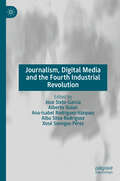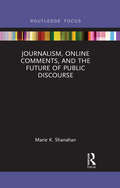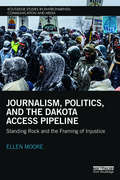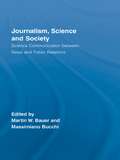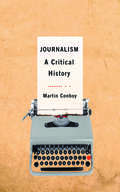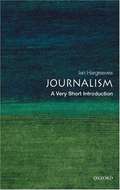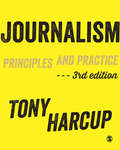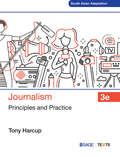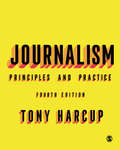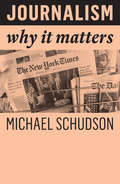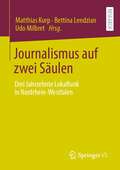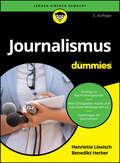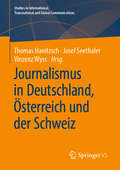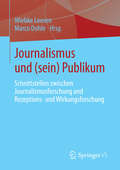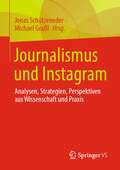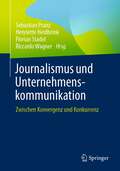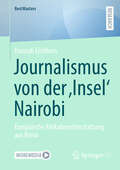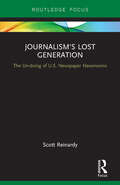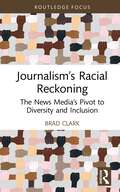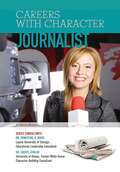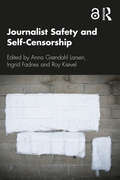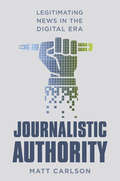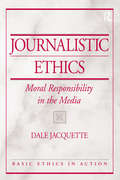- Table View
- List View
Journalism, Digital Media and the Fourth Industrial Revolution
by Alba Silva-Rodríguez José Sixto-García Alberto Quian Ana-Isabel Rodríguez-Vázquez Xosé Soengas-PérezThe Fourth Industrial Revolution, also known as Industry 4.0, is the fourth most important industrial stage that has occurred since the beginning of the Industrial Revolution in the 18th century. This new revolution is characterized by combining cutting-edge production techniques with intelligent systems that integrate with organizations and people. Communication and journalism, especially digital media, face the challenge of integrating emerging technologies and practices or in-test or developing technologies into companies and communicative products, that are breaking down the boundaries between physical, digital, and biological. This collection analyzes and reflects on the impact of Industry 4.0 on journalism and digital media. The collection is split into three parts. The first part analyzes the emergence of centralized and decentralized networks and their impact on digital media. Specifically, it delves into the role of cryptographic journalism and the impactof free and collaborative networks in the fediverse to fight against disinformation and censorship, as well as to promote data and metadata journalism. In a second part, the "innovation of innovation" is explored with the aim of continuing to create products that satisfy the needs of 4.0 audiences. This is where the challenges and opportunities offered by the metaverse, content automation technologies, the impact of the Internet of Things on journalism, labs, the application of R+D+I to journalism, and collaborative encounters between journalists to develop highly innovative proposals are explored. Finally, in the third part of the book, the emergence of new communicative and journalistic actors in the 4.0 context is reviewed. Examples include start-ups, spin-offs or other entrepreneurial initiatives, communication of knowledge transfer, new financing models, and outsourcing of tasks, new proposals for newsgames, or the impact of artificial intelligence in journalism practices. In addition, a final chapter is dedicated to exploring the new professional skills needed for journalists in this Fourth Industrial Revolution.
Journalism, Online Comments, and the Future of Public Discourse
by Marie K. ShanahanComments on digital news stories and on social media play an increasingly important role in public discourse as more citizens communicate through online networks. The reasons for eliminating comments on news stories are plentiful. Off-topic posts and toxic commentary have been shown to undermine legitimate news reporting. Yet the proliferation of digital communication technology has revolutionized the setting for democratic participation. The digital exchange of ideas and opinions is now a vital component of the democratic landscape. Marie K. Shanahan's book argues that public digital discourse is crucial component of modern democracy—one that journalists must stop treating with indifference or detachment—and for news organizations to use journalistic rigor and better design to add value to citizens’ comments above the social layer. Through original interviews, anecdotes, field observations and summaries of research literature, Shanahan explains the obstacles of digital discourse as well as its promises for journalists in the digital age.
Journalism, Politics, and the Dakota Access Pipeline: Standing Rock and the Framing of Injustice (Routledge Studies in Environmental Communication and Media)
by Ellen MooreThis book explores tensions surrounding news media coverage of Indigenous environmental justice issues, identifying them as a fruitful lens through which to examine the political economy of journalism, American history, human rights, and contemporary U.S. politics. The book begins by evaluating contemporary American journalism through the lens of "deep media", focusing especially on the relationship between the drive for profit, professional journalism, and coverage of environmental justice issues. It then presents the results of a framing analysis of the Standing Rock movement (#NODAPL) coverage by news outlets in the USA and Canada. These findings are complemented by interviews with the Standing Rock Sioux Tribe, whose members provided their perspectives on the media and the pipeline. The discussion expands by considering the findings in light of current U.S. politics, including a Trump presidency that employs "law and order" rhetoric regarding people of color and that often subjects environmental issues to an economic "cost-benefit" analysis. The book concludes by considering the role of social media in the era of "Big Oil" and growing Indigenous resistance and power. Examining the complex interplay between social media, traditional journalism, and environmental justice issues, Journalism, Politics, and the Dakota Access Pipeline: Standing Rock and the Framing of Injustice will be of great interest to students and scholars of environmental communication, critical political economy, and journalism studies more broadly.
Journalism, Science and Society: Science Communication between News and Public Relations (Routledge Studies in Science, Technology and Society #Vol. 7)
by Massimiano Bucchi Martin W. BauerAnalyzing the role of journalists in science communication, this book presents a perspective on how this is going to evolve in the twenty-first century. The book takes three distinct perspectives on this interesting subject. Firstly, science journalists reflect on their ‘operating rules’ (science news values and news making routines). Secondly, a brief history of science journalism puts things into context, characterising the changing output of science writing in newspapers over time. Finally, the book invites several international journalists or communication scholars to comment on these observations thereby opening the global perspective. This unique project will interest a range of readers including science communication students, media studies scholars, professionals working in science communication and journalists.
Journalism: A Critical History (Basics Ser.)
by Dr Martin ConboyTraditional news values no longer hold: infotainment has the day. Journalism is in a terminal state of decline. Or so some contemporary commentators would argue. Although there has been a great diversity in format and ownership over time, Conboy demonstrates the surprising continuity of concerns in the history of journalism. Questions of political influence, the impact of advertising, the sensationalisation of news coverage, the 'dumbing down' of the press, the economic motives of newspaper owners - these are themes that emerge repeatedly over time and again today. In this book, Martin Conboy provides a history of the development of newspapers, periodicals and broadcast journalism which · enables readers to engage critically with contemporary issues within the news media · outlines the connections, as well as the distinctions, across historical periods · spans the introduction of printed news to the arrival of the 'new' news media · demonstrates how journalism has always been informed by a cultural practices broader and more dynamic than the simple provision of news By situating journalism in its historical context, this book enables students to more fully understand the wide range of practices which constitute contemporary journalism. As such it will be an essential text for students of journalism and the media.
Journalism: A Very Short Introduction
by Ian HargreavesAlmost everyone reads the newspaper, browses the Internet, listens to the radio or watches TV. Journalism has an indelible effect on our worldview--from the fight against global terrorism to the American presidential elections, celebrity scandal to the latest environmental coups. Hargreaves uses his unique position within the media to examine how we get this information and the many practical, political and professional decisions that the journalist has to make, as part of the process of delivering that information to us. Is journalism the 'first draft of history' or a dumbing-down of our culture and a glorification of the trivial and intrusive? In this intriguing book Ian Hargreaves argues that the core principles of 'freedom of the press' and the necessity of exposing the truth are as vital today as they ever were.
Journalism: Principles and Practice
by Tony HarcupGet 12 months FREE access to an interactive eBook* when you buy the paperback! (Print paperback version only, ISBN 9781446274095) To find out more and for a preview of the new edition visit https://study.sagepub.com/journalism Journalism: Principles & Practice remains the essential textbook for all students of journalism. With each print copy of the new third edition, you receive FREE access to the interactive eBook edition offering on-the-go access to a wealth of digital resources including video tutorials from the author. This book is the must-have guide to everything you need to know about how journalism works. The new edition is fully updated to cover the new essentials: social media, the impact of Twitter, and the need for an ethical approach. This book will equip you with all the skills and savvy you need to become the resourceful yet ethical journalists of the future. New and improved features will help you: Get to grips with the huge impact of social and mobile media on how we gather information and tell stories Grasp the rights and wrongs of journalism with a new chapter on ethics and regulation Learn how to make the most of your skills with tips from journalists such as Cathy Newman and Andrew Norfolk Think through ‘what would you do?' in a new feature that takes you into the real world of journalism at the end of every chapter This new edition retains its innovative two-column structure, stylishly blending theory and practice. As relevant to the newsroom as the seminar room, it is the one book you will need to take you through your degree and into your career as a journalist. *interactivity only available through Vitalsource eBook
Journalism: Principles and Practice
by Tony HarcupGet 12 months FREE access to an interactive eBook* when you buy the paperback! (Print paperback version only, ISBN 9781446274095) To find out more and for a preview of the new edition visit https://study.sagepub.com/journalism Journalism: Principles & Practice remains the essential textbook for all students of journalism. With each print copy of the new third edition, you receive FREE access to the interactive eBook edition offering on-the-go access to a wealth of digital resources including video tutorials from the author. This book is the must-have guide to everything you need to know about how journalism works. The new edition is fully updated to cover the new essentials: social media, the impact of Twitter, and the need for an ethical approach. This book will equip you with all the skills and savvy you need to become the resourceful yet ethical journalists of the future. New and improved features will help you: Get to grips with the huge impact of social and mobile media on how we gather information and tell stories Grasp the rights and wrongs of journalism with a new chapter on ethics and regulation Learn how to make the most of your skills with tips from journalists such as Cathy Newman and Andrew Norfolk Think through ‘what would you do?' in a new feature that takes you into the real world of journalism at the end of every chapter This new edition retains its innovative two-column structure, stylishly blending theory and practice. As relevant to the newsroom as the seminar room, it is the one book you will need to take you through your degree and into your career as a journalist. *interactivity only available through Vitalsource eBook
Journalism: Principles and Practice
by Tony HarcupA textbook that explains the basic concepts of journalism using examples and stories from real life Journalism: Principles and Practice is an essential textbook that tells us about the theory and practice of journalism. This edition covers new topics that are relevant to today's social media, the rights and wrongs of journalism, and digital media among others. It helps the reader to develop the necessary skills to become a modern ethical journalist. The book gives a complete introduction to the fundamental concepts of journalism through entertaining stories and examples from the newsroom. It will be useful to students who are beginning to explore the world of journalism as well as those seeking to gain a deeper understanding of the basic concepts. Key Features: • Updated with contemporary topics such as social media and new methods of gathering information • Simple and clear explanations of the basic concepts of journalism • Relates theory to the real world through exercises that encourage students to think critically • Contains skills and tips from practicing journalists that help students become industry-ready
Journalism: Principles and Practice
by Tony Harcup"A classic text of journalism education that goes beyond the basics to ask the questions that anyone thinking of becoming a journalist really needs to consider. An ethical, entertaining and enduring read - highly recommended." - Michelle Stanistreet, General Secretary, National Union of Journalists This is the one book you need to guide you through university and into your career in journalism. It features stories and tips from a diverse range of journalists, including Ayshah Tull and Cathy Newman of Channel 4 News; Emma Youle of HuffPost; Andrew Norfolk of the Times; and the Mirror’s Nada Farhoud. Covering everything from print to podcasting, it will equip you with the skills and understanding you need to become a successful and ethical journalist. Tony Harcup’s Journalism: Principles and Practice is simply the best guide there is to studying and practising journalism today. "A holistic assessment of what journalism is all about, with plenty of enterprising interpretations of our trade - a word I prefer to ′profession′. I never met a more ′unprofessional′ breed than that of my fellow hacks. This book will, I hope, lead our successors both to question and rebel more than we have." - Jon Snow, Channel 4 News
Journalism: Principles and Practice
by Tony Harcup"A classic text of journalism education that goes beyond the basics to ask the questions that anyone thinking of becoming a journalist really needs to consider. An ethical, entertaining and enduring read - highly recommended." - Michelle Stanistreet, General Secretary, National Union of Journalists This is the one book you need to guide you through university and into your career in journalism. It features stories and tips from a diverse range of journalists, including Ayshah Tull and Cathy Newman of Channel 4 News; Emma Youle of HuffPost; Andrew Norfolk of the Times; and the Mirror’s Nada Farhoud. Covering everything from print to podcasting, it will equip you with the skills and understanding you need to become a successful and ethical journalist. Tony Harcup’s Journalism: Principles and Practice is simply the best guide there is to studying and practising journalism today. "A holistic assessment of what journalism is all about, with plenty of enterprising interpretations of our trade - a word I prefer to ′profession′. I never met a more ′unprofessional′ breed than that of my fellow hacks. This book will, I hope, lead our successors both to question and rebel more than we have." - Jon Snow, Channel 4 News
Journalism: Why It Matters (Why It Matters)
by Michael SchudsonDespite the criticisms that have been leveled at news organizations in recent years and the many difficulties they face, journalism matters. It matters, argues Schudson, because it orients people daily in the complex and changing worlds in which they live. It matters because it offers a fact-centered, documented approach to pertinent public issues. It matters because it keeps watch on the powerful, especially those in government, and can press upon them unpleasant truths to which they must respond. Corruption is stemmed, unwise initiatives stopped, public danger averted because of what journalists do. This book challenges journalists to think hard about what they really do. It challenges skeptical news audiences to be mindful not only of media bias but also of their own biases and how these can distort their perception. And it holds out hope that journalism will be for years to come a path for ambitious, curious young people who love words or pictures or numbers and want to use them to improve the public conversation in familiar ways or in ways yet to be imagined.
Journalismus auf zwei Säulen: Drei Jahrzehnte Lokalfunk in Nordrhein-Westfalen
by Matthias Kurp Bettina Lendzian Udo MilbretDreißig Jahre nach dem Start des Lokalfunks in Nordrhein-Westfalen bietet das Buch Rückblick und Ausblick zugleich. In dem Sammelband finden sich Beiträge von ehemaligen und aktuellen Verantwortlichen, also von Autorinnen und Autoren aus Medienpolitik, ‐wirtschaft und ‐aufsicht, aber auch aus den Bereichen Programm und Wissenschaft. Dabei geht es um eine kritische Bestandsaufnahme und um Szenarien, wie der Lokalfunk in Nordrhein‐Westfalen in der aktuellen publizistischen Breite und Vielfalt weiterentwickelt werden kann.Hinzu kommen eine Chronik sowie Übersichten mit Daten zu Veranstaltergemeinschaften, Betriebsgesellschaften und Chefredakteurinnen oder Chefredakteuren aller Lokalfunkstationen in Nordrhein-Westfalen.
Journalismus für Dummies (Für Dummies)
by Henriette Löwisch Benedikt HerberVom Recherchieren bis zum Publizieren Wie kommt eine Nachricht zustande? Wie sieht ein Tag in der Redaktion aus, und was macht einen guten Journalisten aus? Henriette Löwisch und Benedikt Herber lüften die Berufsgeheimnisse der Journalisten und erklären Ihnen das Nachrichtengeschäft von der Recherche bis zur Publikation. Sie erfahren, welchen Regeln sich Journalisten unterwerfen und welche sie immer wieder gern verletzen. Sie lernen die Tricks des Gewerbes kennen und erhalten Tipps für den Berufseinstieg. Außerdem erfahren Sie, wie die Zukunft des Journalismus aussieht und ob Chatbots die besseren Redakteure sein werden. Sie erfahren Warum eine schlechte Nachricht für Journalisten die bessere ist Wie die besten Stories entstehen Welche Eigenschaften bei Journalisten gefragt sind Wie Ihnen der Einstieg in den Journalismus gelingt
Journalismus in Deutschland, Österreich und der Schweiz (Studies in International, Transnational and Global Communications)
by Thomas Hanitzsch Josef Seethaler Vinzenz WyssDer Band liefert eine Zustandsbeschreibung des Journalismus in einer Zeit, in der Medieninstitutionen ökonomisch unter Druck stehen und journalistische Autoritäten zunehmend hinterfragt werden. Das Buch berichtet Ergebnisse einer Befragung von über 2500 Journalist*innen in Deutschland, Österreich und der Schweiz. Im Zentrum stehen die soziodemografischen Profile der Journalist*innen, die Anstellungsverhältnisse und Tätigkeitsbereiche, ihre beruflichen Rollenverständnisse und ethischen Orientierungen, ihr Vertrauen in gesellschaftliche Institutionen sowie die Wahrnehmung von redaktioneller Autonomie und Einflüssen auf ihre Arbeit.
Journalismus und (sein) Publikum
by Wiebke Loosen Marco DohleDas Bild von der verschwimmenden Grenze zwischen Kommunikator und Rezipient ist das Leitmotiv zur Charakterisierung der gewandelten Kommunikationsverhältnisse im Onlinezeitalter. Die akademische Trennung zwischen Journalismusforschung und Rezeptions- und Wirkungsforschung erschwert es, die damit verbundenen Entwicklungen und Phänomene adäquat zu beschreiben und zu analysieren. Dieser Band versammelt daher Beiträge, die sich mit den Schnittstellen zwischen Journalismusforschung und Rezeptions- und Wirkungsforschung auseinandersetzten und Theorien, Ansätze und Methoden aus beiden Feldern miteinander abgleichen. Im Mittelpunkt steht dabei die Frage, wie eine derart integrierende Perspektive dazu beitragen kann, die gewandelten gesellschaftlichen Kommunikationsverhältnisse theoretisch und empirisch in den Griff zu bekommen.
Journalismus und Instagram: Analysen, Strategien, Perspektiven aus Wissenschaft und Praxis
by Jonas Schützeneder Michael GraßlInstagram ist auf dem Weg, der wichtigste Social-Media-Kanal der Welt zu werden. Dieser Sammelband geht die Forschungslücke im Zusammenspiel von Journalismus und Instagram systematisch und facettenreich an. Autor*innen aus Wissenschaft und Praxis liefern dafür vielfältige Analysen, Strategien und Perspektiven. Wissenschaftliche Verortungen werden ergänzt durch mehrere Fallstudien rund um die journalistische Instagram-Nutzung. Gleichzeitig ermöglichen Praktiker*innen Einblicke auf tägliche Herausforderungen und die Folgen, nicht nur für die Journalist*innen-Ausbildung im Bereich Social Media.
Journalismus und Unternehmenskommunikation: Zwischen Konvergenz und Konkurrenz
by Riccardo Wagner Sebastian Pranz Henriette Heidbrink Florian StadelObwohl sich Journalismus und Unternehmenskommunikation in Funktion und Selbstverständnis immer noch deutlich voneinander unterscheiden, hat die digitale Transformation für eine zunehmende Konvergenz beider Berufsfelder gesorgt. Die Frage, wie und unter welchen Voraussetzungen Öffentlichkeit erzeugt wird, stellt sich angesichts eines tiefgreifenden Medienwandels mit zunehmender Dringlichkeit. Dieses Buch beschreibt das Spannungsverhältnis zwischen beiden Feldern mit Blick auf technologische, ökonomische und praktische Aspekte. Expert*innen aus Journalismus, Unternehmen und Forschung erläutern – wissenschaftlich fundiert und anhand von zahlreichen Praxisbeispielen –, wie sich das neue Miteinander gestaltet: von den jeweils berufsspezifischen Umbrüchen über Wissensvermittlung, -transfer und Netzwerkarbeit bis hin zu neuen Businessmodellen und -strategien für beide Berufsfelder.Ein Buch für Journalist*innen, journalistische Unternehmer*innen, Kommunikationsverantwortliche in Unternehmen, Studierende und praxisorientierte Wissenschaftler*innen.Mit Beiträgen von:• Dr. Matthias Albisser, Hochschule Luzern• Prof. Dr. Christopher Buschow, Bauhaus-Universität Weimar• Prof. Dr. Matthias Degen, Westfälische Hochschule• Prof. Dr. Alexander Godulla, Universität Leipzig• M.A. Benjamin Held, Westfälische Hochschule• Dr. Constanze Jecker, Hochschule Luzern• Prof. Dr. Florian Meißner, Hochschule Macromedia• M.A. Megan Neumann, Ostfalia Hochschule für angewandte Wissenschaften• Prof. Dr. Marc-Christian Ollrog, Ostfalia Hochschule für angewandte Wissenschaften• Rosanna Planer, Universität Leipzig• Prof. Dr. Lars Rademacher, Hochschule Darmstadt• Prof. Dr. Christoph Raetzsch, School of Communication and Culture• Dr. Jonas Schützeneder, Katholische Universität Eichstätt-Ingolstadt• Prof. Dr. René Seidenglanz, Quadriga Hochschule• M.A. Hauke Serger, Bauhaus-Universität Weimar• Dr. Klaus Spachmann, Universität Hohenheim• B.A. Karoline Steinbock, Ostfalia Hochschule für angewandte Wissenschaften• M.A. Maike Suhr, Bauhaus-Universität Weimar• Dr. Daniel Vogel, fög – Forschungszentrum Öffentlichkeit und Gesellschaft• Prof. Dr. Stefan Weinacht, Westfälische Hochschule• Prof. Dr. Cornelia Wolf, Universität Leipzig
Journalismus von der ‚Insel‘ Nairobi: Europäische Afrikaberichterstattung aus Kenia (BestMasters)
by Hannah EichhornJournalismus – als eine der zentralen Quellen, die die Sichtweise auf die Welt prägen – berichtet über die abstrakte Größe des ‚Auslands‘. So entstammt auch ein beträchtlicher Teil unseres Wissens über ‚Afrika‘ journalistischer Produktion. In der kenianischen Hauptstadt Nairobi sind zahlreiche internationale und europäische Medieninstitutionen tätig, die (‚Subsahara‘-)Afrikaberichterstattung für lokale, aber insbesondere für Zielgruppen des globalen Nordens anbieten. Die journalistischen Produkte werden medial durch die Gesellschaften, für die sie berichten, geprägt und haben Auswirkungen auf diese. Europäische Medieninstitutionen agieren in spezifischen Organisationsstrukturen und sind an der (Re-)Produktion medialer Repräsentationen und damit einem entsprechenden Raumexport beteiligt. Europäische Afrikaberichterstattung aus Kenia lässt sich in medialen Organisationsstrukturen, Spannungsfeldern der (Re-)Präsentation, postkolonialen Themen sowie innerhalb globaler Machtverhältnisse und der ‚Glokalität‘ von Auslandsjournalismus verorten. Die vorliegende Arbeit befasst sich mit den Sichtweisen von für europäische Afrikaberichterstattung tätigen Journalist*innen, die für in Nairobi ansässige Medieninstitutionen arbeiten.
Journalism’s Lost Generation: The Un-doing of U.S. Newspaper Newsrooms
by Scott ReinardyJournalism’s Lost Generation discusses how the changes in the industry not only indicate a newspaper crisis, but also a crisis of local communities, a loss of professional skills, and a void in institutional and community knowledge emanating from newsrooms. Reinardy’s thorough and opinionated take on the transition seen in newspaper newsrooms is coupled with an examination of the journalism industry today. This text also provides a broad view of the newspaper journalism being produced today, and those who are attempting to produce it.
Journalism’s Racial Reckoning: The News Media’s Pivot to Diversity and Inclusion (Routledge Focus on Journalism Studies)
by Brad ClarkThis book addresses endemic issues of racism in news media at what is a critical moment in time, as journalists around the world speak out en masse against the prejudice and inequality in the industry. As the events of 2020 – the death of George Floyd, the rise in prominence of the Black Lives Matter movement – have drawn new and focused attention to inequality, white supremacy, and systemic racism, including in the media, this volume chronicles this racial reckoning, revisiting and examining the issues that it has raised. The author analyses media output by racialized and Indigenous journalists, identifying the racial make-up of newsrooms; the dominance of white perspectives in news coverage; interpretations of ethics downplaying systemic racism and bias; ignorance of racist history in editorial decisions and news content; and diversity and inclusion measures. The actions taken by news organizations in response to the reckoning are also detailed and placed in the context of existing race and media scholarship, to offer emerging strategies to address journalism’s longstanding issues with racism in news content and newsrooms. Grounding the interplay between news media and race within this pivotal moment in history, this text will be an important resource for students and scholars of journalism, journalism ethics, sociology, cultural studies, organizational studies, media and communication studies.
Journalist (Careers With Character)
by Sherry BonniceFind out what it takes to be a journalist with character... Journalists have many career areas from which to choose. Some of the most common include: *News reporter; *Editor; *Investigative reporter; *Magazine writer; *Freelance writer; and *Foreign correspondent. Most employers in this field require experience as well as education, and equally important is character. Without the core qualities of a good character, journalists' work does not benefit those it serves. That's why journalists need: Integrity to report a story accurately... Compassion and respect for human beings who need their stories told... And courage to face dangerous situations and withstand pressure. Journalists have the power to fight injustice, ignorance, poverty, and prejudice. Journalist will show you how.
Journalist Safety and Self-Censorship
by Ingrid Fadnes Anna Gr Roy KrThis book explores the relationship between the safety of journalists and self-censorship practices around the world, including local case studies and regional and international perspectives. Bringing together scholars and practitioners from around the globe, Journalist Safety and Self-Censorship provides new and updated insights into patterns of self-censorship and free speech, focusing on a variety of factors that affect these issues, including surveillance, legislation, threats, violent conflict, gender-related stereotypes, digitisation and social media. The contributions examine topics such as trauma, risk and self-censorship among journalists in different regions of the world, including Central America, Estonia, Turkey, Uganda and Pakistan. The book also provides conceptual clarity to the notion of journalist self-censorship, and explores the question of how self-censorship may be studied empirically.Combining both theoretical and practical knowledge, this collection serves as a much-needed resource for any academic, student of journalism, practicing journalist, or NGO working on issues of journalism, safety, free speech and censorship.
Journalistic Authority: Legitimating News in the Digital Era
by Matt CarlsonWhen we encounter a news story, why do we accept its version of events? Why do we even recognize it as news? A complicated set of cultural, structural, and technological relationships inform this interaction, and Journalistic Authority provides a relational theory for explaining how journalists attain authority. The book argues that authority is not a thing to be possessed or lost, but a relationship arising in the connections between those laying claim to being an authority and those who assent to it. Matt Carlson examines the practices journalists use to legitimate their work: professional orientation, development of specific news forms, and the personal narratives they circulate to support a privileged social place. He then considers journalists' relationships with the audiences, sources, technologies, and critics that shape journalistic authority in the contemporary media environment. Carlson argues that journalistic authority is always the product of complex and variable relationships. Journalistic Authority weaves together journalists’ relationships with their audiences, sources, technologies, and critics to present a new model for understanding journalism while advocating for practices we need in an age of fake news and shifting norms.
Journalistic Ethics: Moral Responsibility in the Media
by Dale JacquetteJournalistic Ethics: Moral Responsibility in the Media examines the moral rights and responsibilities of journalists to provide what Dale Jacquette calls “truth telling in the public interest.” With 31 case studies from contemporary journalistic practice, the book demonstrates the immediate practical implications of ethics for working journalists as well as for those who read or watch the news. This case-study approach is paired with a theoretical grounding, and issues include freedom of the press, censorship and withholding sensitive information for the greater public good, protection of confidential sources, journalistic respect for privacy, objectivity, perspective and bias, and editorial license and its obligations. This is a book for anyone who now works in journalism, or is considering a career as a journalist. It is also important groundwork for everyone who follows the day's events in newspapers, radio, television, or on the internet.
